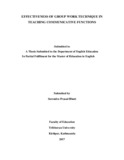Please use this identifier to cite or link to this item:
https://elibrary.tucl.edu.np/handle/123456789/1739| Title: | Effectiveness of Group Work Technique in Teaching Communicative Functions |
| Authors: | Bhatt, Surendra Prasad |
| Keywords: | Group work technique;communicative functions;Effectiveness |
| Issue Date: | 2017 |
| Publisher: | Faculty of Education Engish |
| Abstract: | The research work entitled Effectiveness of Group Work Technique in Teaching Communicative Functions is an attempt to find out the effectiveness of group work technique in course of teaching communicative functions. The main objective of the study was to find out the effectiveness of group work technique in teaching communicative functions. The study was carried out by adopting the experimental research design. The data were collected from pre and post-tests. Twenty-four students from Rainbow International Boarding Secondary School of Kathamandu district were the sample for this study. I selected them by adopting simple random sampling strategy. I divided into two groups: control and experimental. I taught experimental group using group work technique to teach communicative functions for 28 days. I administrated pretest and post-test was in both groups. The data were analyzed using stastical tools like average, percentage and difference between pre-test and post-test. It has been found that students under experimental group have performed better in post-test than controlled group. It means the use of group work technique produced better results than the use other conventional techniques. This study consists of five chapters. The first chapter deals with background of the study, statements of the problem, objectives of the study, research questions, significance of the study, delimitations of the study and operational definitions of the key terms. The second chapter deals with the review of theoretical and empirical literature, implications of the reviewed literature and conceptual framework of the study. Likewise, the third chapter deals with the methodology adopted for the study in which, design of the study, population, sample and sampling strategy of the study, research tools, sources of data, data collection procedures and data analysis and interpretation procedures of the study are discussed. The fourth chapter deals with the analysis and interpretation of the collected data descriptively and using statistical tools like average and percentage. Similarly, the fifth chapter deals with the findings based on the analysis and interpretation of the data, conclusion derived from the findings and recommendations. This chapter is followed by references and appendices. |
| URI: | http://elibrary.tucl.edu.np/handle/123456789/1739 |
| Appears in Collections: | English Language Education |
Files in This Item:
| File | Description | Size | Format | |
|---|---|---|---|---|
| cover (1).pdf | 405.03 kB | Adobe PDF |  View/Open | |
| CHAPTER ONE.pdf | 983.67 kB | Adobe PDF |  View/Open |
Items in DSpace are protected by copyright, with all rights reserved, unless otherwise indicated.
